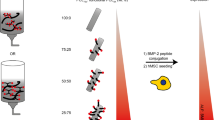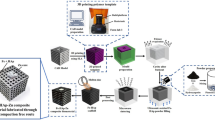Abstract
Well dispersed 45S5 Bioglass® (BG)-graphene nanoplatelets (GNP) composites were prepared after optimising the processing conditions. Fully dense BG nanocomposites with GNP loading of 1, 3 and 5 vol% were consolidated using Spark plasma sintering (SPS). SPS avoided any structural damage of GNP as confirmed using Raman spectroscopy. GNP increased the viscosity of BG-GNP composites resulting in an increase in the sintering temperature by ~50 °C compared to pure BG. Electrical conductivity of BG-GNP composites increased with increasing concentration of GNP. The highest conductivity of 13 S/m was observed for BG-GNP (5 vol%) composite which is ~9 orders of magnitude higher compared to pure BG. For both BG and BG-GNP composites, in vitro bioactivity testing was done using simulated body fluid for 1 and 3 days. XRD confirmed the formation of hydroxyapatite for BG and BG-GNP composites with cauliflower structures forming on top of the nano-composites surface. GNP increased the electrical conductivity of BG-GNP composites without affecting the bioactivity thus opening the possibility to fabricate bioactive and electrically conductive scaffolds for bone tissue engineering.







Similar content being viewed by others
References
Hench LL, Splinter RJ, Allen WC, Greenlee TK. Bonding mechanisms at the interface of ceramic prosthetic materials. J Biomed Mater Res A. 1971;5(6):117.
Hench LL. The story of Bioglass (R). J Mater Sci-Mater M. 2006;17(11):967–78. doi:10.1007/s10856-006-0432-z.
Hench LL. Biomaterials: a forecast for the future. Biomaterials. 1998;19(16):1419–23. doi:10.1016/S0142-9612(98)00133-1.
Ducheyne P, Qiu Q. Bioactive ceramics: the effect of surface reactivity on bone formation and bone cell function. Biomaterials. 1999;20(23–24):2287–303. doi:10.1016/S0142-9612(99)00181-7.
Lopez-Esteban S, Saiz E, Fujino S, Oku T, Suganuma K, Tomsia AP. Bioactive glass coatings for orthopedic metallic implants. J Eur Ceram Soc. 2003;23(15):2921–30. doi:10.1016/S0955-2219(03)00303-0.
Bahniuk MS, Pirayesh H, Singh HD, Nychka JA, Unsworth LD. Bioactive glass 45S5 powders: effect of synthesis route and resultant surface chemistry and crystallinity on protein adsorption from human plasma. Biointerphases. 2012;7(1–4):41. doi:10.1007/S13758-012-0041-Y.
Xynos ID, Edgar AJ, Buttery LDK, Hench LL, Polak JM. Ionic products of bioactive glass dissolution increase proliferation of human osteoblasts and induce insulin-like growth factor II mRNA expression and protein synthesis. Biochem Bioph Res Co. 2000;276(2):461–5. doi:10.1006/bbrc.2000.3503.
Cao WP, Hench LL. Bioactive materials. Ceram Int. 1996;22(6):493–507. doi:10.1016/0272-8842(95)00126-3.
Drnovsek N, Novak S, Dragin U, Ceh M, Gorensek M, Gradisar M. Bioactive glass enhances bone ingrowth into the porous titanium coating on orthopaedic implants. Int Orthop. 2012;36(8):1739–45. doi:10.1007/s00264-012-1520-y.
Gorustovich AA, Roether JA, Boccaccini AR. Effect of bioactive glasses on angiogenesis: a review of in vitro and in vivo evidences. Tissue Eng Part B Rev. 2010;16(2):199–207. doi:10.1089/ten.teb.2009.0416.
Zhang D, Lepparanta O, Munukka E, Ylanen H, Viljanen MK, Eerola E, et al. Antibacterial effects and dissolution behavior of six bioactive glasses. J Biomed Mater Res A. 2010;93A(2):475–83. doi:10.1002/Jbm.A.32564.
Anderson AB, Dallmier AW, Chudzik SJ, Duran LW, Guire PE, Hergenrother RW, et al. Technologies for the surface modification of biomaterials. In: Yaszemski MJ, Trantolo DJ, Lewandrowski KU, Hasirci V, Altobelli DE, Wise DL, editors. Biomaterials in orthopedics. New York: Marcel Dekker Inc; 2004. p. 123.
Sanchez VC, Jachak A, Hurt RH, Kane AB. Biological interactions of graphene-family nanomaterials: an interdisciplinary review. Chem Res Toxicol. 2012;25(1):15–34. doi:10.1021/Tx200339h.
Supronowicz PR, Ajayan PM, Ullmann KR, Arulanandam BP, Metzger DW, Bizios R. Novel current-conducting composite substrates for exposing osteoblasts to alternating current stimulation. J Biomed Mater Res. 2002;59(3):499–506. doi:10.1002/Jbm5.
Hrapovic S, Liu YL, Male KB, Luong JHT. Electrochemical biosensing platforms using platinum nanoparticles and carbon nanotubes. Anal Chem. 2004;76(4):1083–8. doi:10.1021/Ac035143t.
Khang D, Park GE, Webster TJ. Enhanced chondrocyte densities on carbon nanotube composites: the combined role of nanosurface roughness and electrical stimulation. J Biomed Mater Res A. 2008;86A(1):253–60. doi:10.1002/Jbm.A.31803.
Yang WR, Thordarson P, Gooding JJ, Ringer SP, Braet F. Carbon nanotubes for biological and biomedical applications. Nanotechnology. 2007;18(41):412001. doi:10.1088/0957-4484/18/41/412001.
Li XM, Gao H, Uo M, Sato Y, Akasaka T, Feng QL, et al. Effect of carbon nanotubes on cellular functions in vitro. J Biomed Mater Res A. 2009;91A(1):132–9. doi:10.1002/Jbm.A.32203.
Zanello LP, Zhao B, Hu H, Haddon RC. Bone cell proliferation on carbon nanotubes. Nano Lett. 2006;6(3):562–7. doi:10.1021/Nl051861e.
Meng D, Rath SN, Mordan N, Salih V, Kneser U, Boccaccini AR. In vitro evaluation of 45S5 Bioglass®-derived glass-ceramic scaffolds coated with carbon nanotubes. J Biomed Mater Res A. 2011;99A:435–44.
Afrin R, Khaliq J, Islam M, Gul IH, Bhatti AS, Manzoord U. Synthesis of multiwalled carbon nanotube-based infrared radiation detector. Sensor Actuat a-Phys. 2012;187:73–8. doi:10.1016/j.sna.2012.08.028.
Lee C, Wei XD, Kysar JW, Hone J. Measurement of the elastic properties and intrinsic strength of monolayer graphene. Science. 2008;321(5887):385–8. doi:10.1126/science.1157996.
Geim AK, Novoselov KS. The rise of graphene. Nat Mater. 2007;6(3):183–91.
Balandin AA, Ghosh S, Bao WZ, Calizo I, Teweldebrhan D, Miao F, et al. Superior thermal conductivity of single-layer graphene. Nano Lett. 2008;8(3):902–7. doi:10.1021/Nl0731872.
Porwal H, Tatarko P, Grasso S, Hu C, Boccaccini AR, Dlouhý I et al. Toughened and machinable glass matrix composites reinforced with graphene and graphene-oxide nano platelets. Sci Technol Adv Mat. 2013;14:055007. doi:10.1088/1468-6996/14/5/055007.
Fan YC, Wang LJ, Li JL, Li JQ, Sun SK, Chen F, et al. Preparation and electrical properties of graphene nanosheet/Al2O3 composites. Carbon. 2010;48(6):1743–9. doi:10.1016/j.carbon.2010.01.017.
Cho J, Boccaccini AR, Shaffer MSP. Ceramic matrix composites containing carbon nanotubes. J Mater Sci. 2009;44(8):1934–51. doi:10.1007/s10853-009-3262-9.
Fabbri P, Valentini L, Hum J, Detsch R, Boccaccini AR. 45S5 Bioglass®-derived scaffolds coated with organic–inorganic hybrids containing graphene. Mater Sci Eng C. 2013;33(7):3592–600.
Porwal H, Grasso S, Reece M. Review of graphene-ceramic matrix composites. Adv Appl Ceram. 2013;112(8):443. doi:10.1179/174367613X13764308970581.
Walker LS, Marotto VR, Rafiee MA, Koratkar N, Corral EL. Toughening in graphene ceramic composites. ACS Nano. 2011;5(4):3182–90. doi:10.1021/Nn200319d.
Kvetkova L, Duszova A, Hvizdos P, Dusza J, Kun P, Balazsi C. Fracture toughness and toughening mechanisms in graphene platelet reinforced Si3N4 composites. Scripta Mater. 2012;66(10):793–6. doi:10.1016/j.scriptamat.2012.02.009.
Grasso S, Chinnam RK, Porwal H, Boccaccini AR, Reece MJ. Low temperature spark plasma sintering of 45S5 Bioglass®. J Non-Cryst Solids. 2013;362:25–9.
Porwal H, Tatarko P, Grasso S, Khaliq J, Dlouhý I, Reece M. Graphene reinforced alumina nano-composites. Carbon. 2013;64:359–69. doi:10.1016/j.carbon.2013.07.086.
Khan U, O’Neill A, Lotya M, De S, Coleman JN. High-concentration solvent exfoliation of graphene. Small. 2010;6(7):864–71. doi:10.1002/smll.200902066.
Yi M, Shen ZG, Zhang XJ, Ma SL. Achieving concentrated graphene dispersions in water/acetone mixtures by the strategy of tailoring Hansen solubility parameters. J Phys D Appl Phys. 2013;46(2):025301. doi:10.1088/0022-3727/46/2/025301.
Khan U, O’Neill A, Porwal H, May P, Nawaz K, Coleman JN. Size selection of dispersed, exfoliated graphene flakes by controlled centrifugation. Carbon. 2012;50(2):470–5. doi:10.1016/j.carbon.2011.09.001.
Khan U, May P, Porwal H, Nawaz K, Coleman JN. Improved adhesive strength and toughness of polyvinyl acetate glue on addition of small quantities of graphene. Acs Appl Mater Inter. 2013;5(4):1423–8. doi:10.1021/Am302864f.
Tadashi Kokubo HT. How useful is SBF in predicting in vivo bone bioactivity? Biomaterials. 2006;27(15):2907–15.
Bednarcik J, Michalik S, Kolesar V, Rutt U, Franz H. In situ XRD studies of nanocrystallization of Fe-based metallic glass: a comparative study by reciprocal and direct space methods. Phys Chem Chem Phys. 2013;15(22):8470–9. doi:10.1039/C3cp44445g.
Balandin AA. Thermal properties of graphene and nanostructured carbon materials. Nat Mater. 2011;10(8):569–81. doi:10.1038/Nmat3064.
Yoon D, Son YW, Cheong H. Negative thermal expansion coefficient of graphene measured by Raman spectroscopy. Nano Lett. 2011;11(8):3227–31. doi:10.1021/Nl201488g.
Tsoukleri G, Parthenios J, Papagelis K, Jalil R, Ferrari AC, Geim AK, et al. Subjecting a graphene monolayer to tension and compression. Small. 2009;5(21):2397–402. doi:10.1002/smll.200900802.
Cho J, Inam F, Reece MJ, Chlup Z, Dlouhy I, Shaffer MSP, et al. Carbon nanotubes: do they toughen brittle matrices? J Mater Sci. 2011;46(14):4770–9. doi:10.1007/s10853-011-5387-x.
Peitl O, LaTorre GP, Hench LL. Effect of crystallization on apatite-layer formation of bioactive glass 45S5. J Biomed Mater Res. 1996;30(4):509–14.
Chen QZ, Thompson ID, Boccaccini AR. 45S5 Bioglass®-derived glass–ceramic scaffolds for bone tissue engineering. Biomaterials. 2006;27(11):2414–25.
Acknowledgments
The authors would like to thank European Union’s Seventh Framework Programme managed by REA-Research Executive Agency http://ec.europa.eu/research/rea (Marie Curie Action, GlaCERCo GA 264526) for their support and funding for this research. We are also grateful to Dr. Mahesh Kumar Mani (Cardiff University, UK) and Mr Rama Krishna Chinnam (University of Erlangen-Nuremberg, Germany) for helping with some experiments.
Author information
Authors and Affiliations
Corresponding author
Rights and permissions
About this article
Cite this article
Porwal, H., Grasso, S., Cordero-Arias, L. et al. Processing and bioactivity of 45S5 Bioglass®-graphene nanoplatelets composites. J Mater Sci: Mater Med 25, 1403–1413 (2014). https://doi.org/10.1007/s10856-014-5172-x
Received:
Accepted:
Published:
Issue Date:
DOI: https://doi.org/10.1007/s10856-014-5172-x




